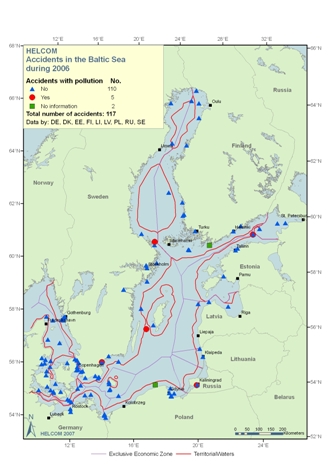Press release
HELCOM reports a noticeable drop in shipping accidents in the Baltic
 Helsinki, 27 June (HELCOM Information Service) - The annual number of shipping accidents in the Baltic Sea area, including also accidents resulting in oil spills, has significantly decreased for the first time since 2004, although it is still almost twice as high as four-five years ago, according to the latest study released today by the Helsinki Commission for the protection of the Baltic marine environment.
Helsinki, 27 June (HELCOM Information Service) - The annual number of shipping accidents in the Baltic Sea area, including also accidents resulting in oil spills, has significantly decreased for the first time since 2004, although it is still almost twice as high as four-five years ago, according to the latest study released today by the Helsinki Commission for the protection of the Baltic marine environment.
Analysis of the data contained in the latest national annual reports provided by all the Baltic Sea coastal countries to HELCOM reveals that there were 117 accidents in 2006, compared to 146 in 2005, and 142 in 2004. In 2006, only 5 accidents resulted in small-scale pollution, compared to 13 similar cases in the previous year. In 2000-2003, on an average there were only around 60 accidents recorded each year in the Baltic.
“The latest noticeable decrease in the number of accidents at sea, despite the rapidly growing maritime traffic in the region, is a very welcome development, and we very much hope that it will constitute the beginning of a downward trend," says Anne Christine Brusendorff, Executive Secretary of HELCOM. “But nevertheless the current annual number of accidents is still unacceptable, especially taking into account a 100% increase in 2004, compared to the 2000-2003 data.”
According to HELCOM experts, one possible explanation for the apparent increase back in 2004 is the new reporting requirements for shipping accidents recently established by HELCOM. It is still clear, however, that the rapidly growing maritime traffic in the region could also have contributed to this increase in the number of accidents.
Currently, there are around 2,000 ships at sea at any given moment, accounting for 15% of the world’s cargo transportation. According to the HELCOM Automatic Identification System (AIS) for monitoring maritime traffic in the Baltic, more than 50,000 vessels annually pass the Skaw at the northernmost tip of Denmark on their way into or out of the Baltic Sea. Forecasts indicate that due to economic growth, especially in the eastern part of the region, the amount of cargo shipped on the Baltic will double by 2015 from 500 million tonnes to 1,000 million tonnes annually. Oil transportation is particularly to increase, especially in the Gulf of Finland due to the construction and expansion of Russian oil terminals. According to forecasts, by 2010 total amount of oil transported in the Baltic will increase from current 110 million tonnes to 190 million tonnes a year.
“The latest report shows that most of the accidents occurred in the south-western Baltic Sea,” says Monika Stankiewicz, HELCOM’s Professional Secretary. “Collisions were the most common type of accidents in the Baltic accounting for almost a half of all reported cases (46%) and for a second year in a row surpassing the number of groundings (39%). The share of both types of accidents has increased as much as 10% for collisions and 2% for groundings compared to 2005. Other major types of accidents included fires/explosions (6%) and machinery damage (4%). Ship to ship collisions (29 cases) accounted for 52% of all collision cases in 2006, and the rest of the cases were collisions with fixed or floating structures, e.g. piers, navigation signs etc.”
Cargo vessels (56%), tankers (15%) and passenger ferries (17%) were the main types of vessels involved in the accidents. The main cause of accidents in 2006 is not as clear as the year before due to the lack of information in 35% of the cases. However, human factor (36%) seems to continue to be the main reason, followed by technical factors (15%).
Of the 5 small oil spills which occurred as a result of accidents in 2006, the largest of them contained 150 cubic metres of oil (following a collision of two cargo vessels in the Gulf of Finland) and 10 cubic metres of oil (following a grounding of a vessel in the port of Kaliningrad), and the rest were no more than 0.1 cubic metre in volume.
Fortunately, most of the accidents in the Baltic do not cause notable pollution, but even one large-scale accident would seriously threaten the marine environment. Over the period 2000-2006, an average of 7% of all reported accidents resulted in some kind of pollution. Two of the five most serious accidents in the Baltic marine area have occurred since 2001 – involving “Baltic Carrier” in 2001 (2,700 tonnes of oil spilt), and “Fu Shan Hai” in 2003 (1,200 tonnes of oil spilt).
Follow-up:
HELCOM report on shipping accidents in 2006: http://www.helcom.fi/stc/files/shipping/shipping_accidents_2006.pdf .
Note to Editors:
The Baltic Marine Environment Protection Commission, more usually known as the Helsinki Commission, or HELCOM, is an intergovernmental organisation of all the nine Baltic Sea countries and the EU which works to protect the marine environment of the Baltic Sea from all sources of pollution.
HELCOM is the governing body of the "Convention on the Protection of the Marine Environment of the Baltic Sea Area," known as the Helsinki Convention.
For more information, please contact:
Ms. Monika Stankiewicz
Professional Secretary
HELCOM
Tel: +358 (0)207 412 643
Fax: +358 (0)207 412 639
E-mail: monika.stankiewicz@helcom.fi
Mr. Nikolay Vlasov
Information Secretary
HELCOM
Tel: +358 (0)207 412 635
Fax: +358 (0)207 412 639
E-mail: nikolay.vlasov@helcom.fi

